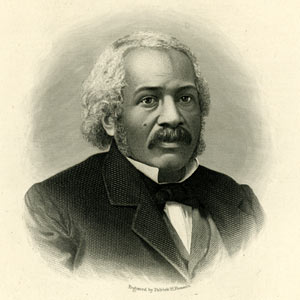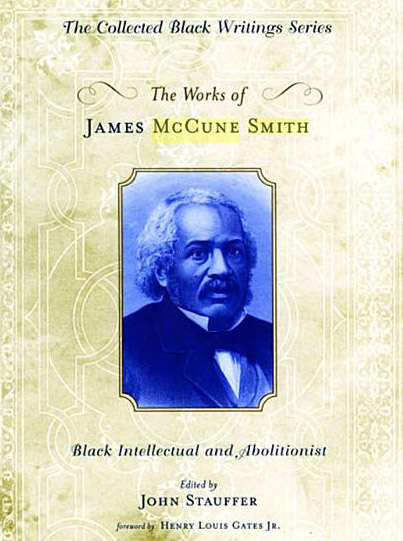Black History Month 2022-Day 19: James McCune Smith
Dr. James McCune Smith is a man we don’t hear of during Black History Month. This multitalented and multifaceted man was known more in the areas of literary scholarship, medicine, and social activism than in chess. If you knew this man, chances are that you are a 19th-century American history buff.
Sometimes a single article, book, song, or work of art can make a lasting impression. I wrote about Smith back in 2006 after reading his essay simply called, “Chess.” The exquisite manner in which he describes the New York scene of 1857, places one in the midst of troubled times. However, chess became his suggested refuge.
In my introduction, I wrote:

James McCune Smith was such a man of erudition. Born on April 18, 1813, he was the son of an enslaved mother and developed into one of the most brilliant minds of his day. He attended schools in New York City, but because of blatant racism, wasn’t allowed to enter any of the U.S. colleges at the time. He decided to move to Scotland to attend Glasgow University where, by age 19, he would earn three degrees including a Doctor of Medicine. After an internship in Paris in 1837, he returned to his home state of New York where he became the first Black physician.
While in Scotland, he had joined the Glasgow Emancipation Society and upon his return began to fight the cause for the abolition of slavery. A Frederick Douglass contemporary, he understood the challenges of Black life in America and sought to build institutions and organizations for Black self-empowerment. With Douglass, he helped to establish the The National Council of the Colored People and passed away on November 17, 1865 of heart disease. His life’s work was not in vain as he saw slavery abolished the year of his death.
The Chess Artist

Smith straddled between worlds due to his mulatto heritage. He was part of the elite class but fought against the vestiges of classism/racism. Last year, I purchased a collection of his writings titled, The Works of James McCune Smith: Black Intellectual and Abolitionist edited by John Stauffer. What impressed me most was not his erudite scholarship, but his beautiful and delicate prose. It is no accident that Frederick Douglass, himself so impressed with Smith, that he asked him to write the introduction to his epic work, My Bondage, and My Freedom.
As far as his chess interests, there is not much of a record of his actual play, except in his article, “The Critic at Chess.” He was conversant with chess opening theory and the contemporary players. His chess essay provided a first-hand count of two legends that captured his enthusiasm for the royal game. In that immortal passage, he describes chess champions Louis Paulsen and Paul Morphy as only he could.
Having seen their portraits in Frank Leslie, we instantly singled out Paulsen and his great antagonist, and a little skillful elbowing found us seated beside their board. There was Louis Paulsen, with his vast head, sanguine temperament, but coarse fibre, indicating his rough, almost pure-Bersekir blood; and as we gazed at Morphy, with his fine, open countenance, brunette hue, marvelous delicacy of fibre, bright, clear eyes, and elongated submaxillary bone, a keen suspicion entered our ethnological department that we were not the only Carthaginian in the room. It might only be one drop, perhaps two, God only knows how they got there but surely, beside the Tria mulattin who at present writes, there was also a Hekata-mulattin in that room!
The implication here is because of his features, Morphy appeared to have African ancestry. This is a common claim by those referring to Morphy’s ancestry in the Caribbean. According to Morphy’s maternal lineage in the Caribbean, they once resided in Saint Domingue (landmass shared by the Dominican Republic and Haiti), but all previously migrated from France.
Of course, the French settled in the Caribbean which precipitated the famous Haitian Revolution. Toussaint L’Ouverture led men to battle to vanquish the French and to control what was also known as “Hispaniola.” Later the Spanish were able to battle successfully for half of Hispaniola, now know as the Dominican Republic. It is with a sense of irony that in 1841, Smith spoke eloquently on the “Haytien Revolution” and the exploits of L’Ouverture (HTML, PDF).
“Yet chess-playing is an amusement worthy of cultivation, especially for the young. It is better in-door entertainment than cards, or dice, or lager-bier; it has been well said that it does not lead to gambling. It has the positive merit of improving the tone of manners and of cultivating the power of attention.”
~ James McCune Smith

Image courtesy of Ian Brabner, Rare Americana, LLC.
The Polymath Visionary
There may never be another man as versatile of a scholar as Smith. He was fluent in a number of languages including ancient Greek, Latin, and French. He also had some command of Spanish, German, Italian, and Hebrew. He wrote medical case reports, poetry, esoteric essays, and socially-provocative articles on a variety of disciplines. Here he offers chess as a respite from the troubled economic times of 1857.
…while men in Broadway and other streets adjacent the masters suddenly arrested in their golden dreams of enormous profit, and the workmen sadly folding up their implements of labor; and while the poor, frantic with an unknown dread, rushed to the savings banks, or gathered in bread mobs in distant parks in the midst of this social hurricane, there was one house in Broadway, in which men daily gathered, and matters went on “Calm as a summer’s sea,” the very centre of the vortex, yet calm as a moonlit pool, so deeply embayed in mountains, that no breath of air could reach it a land-locked haven, in which whoever entered, however storm riven or care-crushed, became calm and still, and hung up his votive offerings to the genius loci; which was neither music, nor dancing, nor dice, nor wine, nor opium, nor lotus, nor hasheesh, but simply Chess! the immortal game, painted as played on the inside of the tomb of Nevotp, the Egyptian, 3,000 years B.C.; but who can paint it as played at Donadi’s rooms in Broadway, in the year of grace 1857?
The vivid nature in which he describes the conflicting emotions amidst economic turmoil are brilliant indeed. At a time of failing businesses, bread lines, and bank runs, you have an innocent suggestion… play chess. His apparent reference to chess on the walls of Nevotp’s tomb was most likely the game of “Senet.” Nevertheless, his reverence for chess was clear! His essays are recommended reading and may give an idea of the challenges that were ahead for the Black community… and still lay ahead.


It is interesting that at the same event Smith attended, there was a rule created about the move order of a game of chess.
At the First American Chess Congress in 1857, England’s Johann Lowenthal recommended that white have the obligatory first move. The book commemorating the congress, sets the tone: